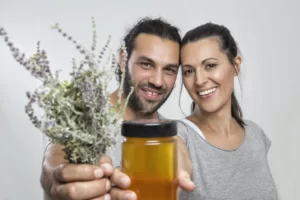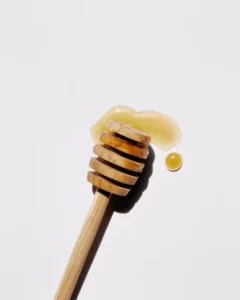Table of Contents
Introduction
When it comes to DIY skincare, there are a few ingredients that are always a safe bet. One such ingredient is honey, which has been used for food and medicinal purposes since ancient times. Honey is not only delicious but also has numerous benefits for your skin. In particular, manuka honey, a type of honey native to New Zealand and Australia, is known for its exceptional healing properties. In this article, we will explore why your skin loves honey face masks and provide you with eight easy recipes to make your own manuka honey masks at home.
Why Honey?
Honey is a natural antibacterial agent, making it effective in reducing inflammation and fighting acne-causing bacteria that can lead to breakouts. It is also a humectant, which means it draws moisture from the air and helps keep your skin hydrated and smooth. Additionally, honey can break down excess sebum that clogs your pores and contributes to acne.
For the best results, it is recommended to use raw, organic, unfiltered honey. However, if you want to experience the full benefits of honey, splurging on manuka honey is worth considering. This type of honey is derived from the Manuka tree and has exceptional antibacterial properties, making it a superfood for your skin. It is also known for its immune-boosting and wound-healing benefits.
How to Use Honey on Your Face
While there are many skincare products available on the market, sometimes it’s best to go back to basics and use natural ingredients like honey. Honey can be used in various ways on your face, including as a cleanser, scrub, or face mask. It can easily be incorporated into your skincare routine and provides a great complement to any other products you may be using.
To use honey on your face, start with clean skin and open up your pores by placing a warm, wet washcloth on your face. This will help the honey penetrate deeply into your skin. After applying the honey mask, rinse off with warm water and follow up with cold water or a toner to close your pores. Finally, apply a good face oil to moisturize and nourish your skin.
8 Manuka Honey Face Mask Recipes
- Manuka Honey & Baking Soda Mask for Acne-Prone Skin
Baking soda is known for its anti-inflammatory and antibacterial properties, making it a favorite among dermatologists. When combined with lemon juice and soothing manuka honey, it creates a gentle yet effective mask to control acne.
Ingredients:
– 1 teaspoon lemon juice
– 1 tablespoon organic raw manuka honey
– 1 teaspoon baking soda
Instructions:
– In a small bowl, mix lemon juice, honey, and baking soda until well combined.
– Apply the mixture to your face and neck, avoiding the eye area.
– Leave the mask on for 15 minutes.
– Rinse off with warm water, followed by cold water.
Note: Due to the photosensitivity of lemon, it is recommended to apply this mask in the evening and use sunscreen the next day when going out.
- Manuka Honey Face Mask for Oily Skin
Clay masks are known for their ability to control oily skin, but honey can also be beneficial in this regard. Honey helps regulate sebum production, making it an excellent option for those with oily skin. Bentonite clay and Moroccan red clay are two great choices for balancing natural oils and treating acne-prone skin.
Ingredients:
– 1 teaspoon organic raw manuka honey
– 1 teaspoon Bentonite clay or Moroccan red clay powder
– 1 teaspoon organic, raw apple cider vinegar
Instructions:
– In a small nonreactive bowl, combine the clay, honey, and apple cider vinegar. Stir well.
– Gently apply the mixture to your face and neck.
– Leave the mask on for 15 minutes.
– Rinse off with warm water, followed by cold water.
- Manuka Honey Face Mask for Inflammation
Green tea and honey are both known for their anti-inflammatory properties, making them a powerful combination to soothe skin redness and inflammation. This mask is gentle enough for sensitive skin and provides potent antioxidants to repair damaged skin.
Ingredients:
– 1 teaspoon matcha powder
– 1 tablespoon organic raw manuka honey
– 1 teaspoon sweet almond or jojoba oil
Instructions:
– In a small bowl, mix matcha powder, honey, and your choice of oil until well combined.
– Apply the mixture to your face and leave it on for 15 minutes.
– Rinse off with warm water.
- Manuka Honey Face Mask for Dry Skin
If you have dry skin, a combination of honey and avocado is perfect for hydrating and nourishing your skin. Ground almonds gently exfoliate, while the good fats in avocado leave your skin feeling soft and moisturized.
Ingredients:
– 2 tablespoons organic raw manuka honey (or 1 tablespoon honey and 1 tablespoon of jojoba or sweet almond oil)
– ¼ mashed avocado
– 2 tablespoons finely ground almonds
Instructions:
– In a small bowl, mash together honey and avocado.
– Stir in the ground almonds.
– Spread the mixture over your face and neck.
– After 15-20 minutes, rinse off with warm water.
- Manuka Honey Mask for Discoloration
Honey is a natural exfoliator that can help improve the skin’s radiance. Combining it with turmeric can brighten the skin, while adding oils can nourish it. Turmeric has anti-inflammatory properties that can reduce redness, puffiness, and irritation.
Ingredients:
– 1 teaspoon lemon juice
– 1 tablespoon organic raw manuka honey
– 1 tablespoon yogurt
– ¼ teaspoon turmeric powder
Instructions:
– Mix all the ingredients together in a small bowl.
– Apply a thin layer of the mixture to your face and neck.
– Leave it on for 20 minutes.
– Rinse off with warm water.
Repeat this mask weekly or use it as a daily spot treatment for areas of discoloration. Results may take 2 to 3 months to show.
- Manuka Honey Mask to Fight Pollution
Vitamin E is a powerful antioxidant that repairs and protects the skin from free radical damage caused by air pollution and UV rays. This mask combines the benefits of honey and vitamin E to protect and repair your skin.
Ingredients:
– 1 capsule vitamin E
– 1 tablespoon organic raw manuka honey
Instructions:
– In a small bowl, mix the vitamin E capsule with the honey to form a paste.
– Apply the paste to your face and leave it on for 15 minutes.
– Rinse off with warm water and a washcloth.
You may need to wash your face multiple times to remove the entire mask. Follow up with a moisturizer or serum.
- Manuka Honey Mask for Sensitive Skin
Oatmeal is known for its soothing properties and is often used to calm irritated or sensitive skin. Combined with the antibacterial properties of manuka honey, this mask is an excellent choice for acne-prone skin that is easily irritated or sensitive.
Ingredients:
– 1 tablespoon manuka honey
– 2 tablespoons cooked oatmeal
Instructions:
– Mix the honey and oatmeal together to form a thick paste.
– Apply the paste to your face, paying special attention to irritated areas.
– Leave it on for 15-20 minutes.
– Remove the mask with warm water.
- Manuka Honey Mask for Aging Skin
Eggs contain lutein, which helps hydrate and repair skin tissue. When combined with the moisture-retaining properties of honey and the skin-firming benefits of frankincense essential oil, you have a powerful mask for aging skin.
Ingredients:
– 1 tablespoon organic raw manuka honey
– 1 egg white
– 2 drops frankincense essential oil
Instructions:
– Mix the egg white and honey together.
– Add the frankincense essential oil and stir well.
– Apply the mixture to your face and neck, avoiding the eye area.
– Leave the mask on for 10-15 minutes.
– Rinse off with warm water and apply a serum or moisturizer.
Conclusion
Manuka honey masks offer numerous benefits for your skin. Whether you have acne-prone, oily, dry, sensitive, discolored, or aging skin, there is a manuka honey mask recipe that can help address your specific concerns. By incorporating these masks into your skincare routine, you can enjoy the natural healing and nourishing properties of manuka honey and achieve a healthier, more radiant complexion.
Note: This article was medically reviewed by Dr. Jennifer Haley, a board-certified dermatologist with extensive experience in medical, cosmetic, and surgical dermatology. Please consult with your doctor or dermatologist before trying any new skincare regimen.



